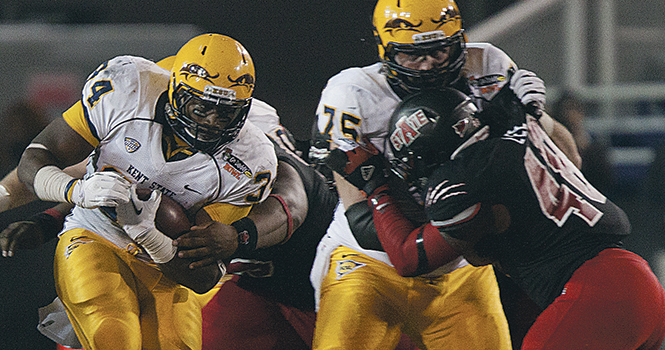Flashes lost more than the MAC Championship in November
May 1, 2013
Spencer Keith, Kent State quarterback, drifted to his right and threw a desperate pass into the endzone at Ford Field in Detroit.
The ball was taken away by a Northern Illinois defender, and with it, any hope the Flashes had of going to the 2013 Discover Orange Bowl. The Flashes lost the Mid-American Conference Championship in heartbreaking fashion to the Northern Illinois Huskies 44-37 in double overtime.
Not only did the Flashes miss the opportunity to be the first MAC team to play in a BCS bowl game, but the university also may have missed out on a potentially big payday.
Northern Illinois released its bowl finance report to the Daily Kent Stater last week, and the report showed the Huskies program made $253,780 from its trip to the Orange Bowl in South Florida.
Meanwhile, Kent State lost $44,340 traveling to the GoDaddy.com Bowl in Mobile, Ala., but athletic director Joel Nielsen doesn’t look at it as “a loss.”
“I like to say we invested $44,000 in the program,” Nielsen said. “[The GoDaddy.com Bowl] was basically a three-hour commercial for the program and the institution.”
Attention Has Value
Nielsen compared the game to the baseball team’s run to the College World Series last summer. The university paid a firm to quantify how much the media exposure was worth to the university.
The company determined that games on television, radio coverage, highlights on major sports networks and overall attention were worth about $3.5 million to the university.
While that money doesn’t necessarily go into the athletic department right away, Nielsen said major exposure can be quantified, and it is important to any program.
Ticket Troubles
As far as immediate returns, the MAC allows teams to keep 100 percent of ticket revenue to any bowl game. The problem is, many bowl games are too far away to sell a lot of tickets.
Kent State sold nearly $25,000 in tickets for the GoDaddy.com Bowl and still ended up losing money, but it could have been a lot worse.
Northern Illinois was given 17,500 tickets to sell for the Orange Bowl, but the university was only able to sell a little more than 3,000. The school was going to be on the hook to lose more than $1 million, as it would have to pay for the unsold seats.
But the MAC stepped in and covered the entire cost of the tickets. Nielsen said he supported the move because it’s not fair to ask a MAC team to sell that many tickets to a game more than 1,000 miles away.
Housing and Transporting Student Athletes
One of the bigger expenses the university faced was housing students before they even went to Alabama. Many of the players live on campus, and when winter break hit and residence and dining halls closed, the students still had to be in Kent for practices.
“We had to put a lot of them in hotels, and we had to feed them too,” Nielsen said with a laugh. “It costs about $5,000 a day to feed the team, and we did that for a bunch of days.”
Overall, the majority of the cost came from team, staff, band and cheer travel, which totaled about $443,000. Even that could have been more, as Nielsen said the university saved about $100,000 when it found a smaller charter plane to get the team to Alabama.
Is it Worth it?
University President Lester Lefton was not made available to the Daily Kent Stater for this article, but he has previously said he thinks the bowl system needs a bit of a makeover.
In an interview Plain Dealer reporter Elton Alexander in 2012, Lefton compared Kent State going to a bowl game to having twins.
“Nobody wants to have twins. But if you have them, you might as well appreciate them,” Lefton said. “I just think bowl games that are too far away just cost too much. Planes, trains, automobiles, it’s too much of a burden on the kids, the students, the coaches and the fans. I’d rather that we be closer.”
Nielsen agreed with Lefton’s sentiment. He pointed out that the majority of MAC teams that make the Little Caesar’s Bowl in Detroit usually break even or make money from the game.
The two reasons Northern Illinois made more than $250,000 were because the MAC paid for the tickets and the bonus for playing in the Orange Bowl is massive.
The Huskies making the Orange Bowl made the MAC $8 million, so buying the tickets and awarding the team a little more than $1.3 million made sense, according to Nielsen.
What did Kent State Really Get From the Bowl Game?
The university has not analyzed how much exposure it gained from the GoDaddy.com Bowl, but Nielsen said he’s confident that it is worth “10 to 20 times” more than the university “invested.”
Nielsen was quick to say that $44,000 is a lot of money, but he pointed out that the university’s annual budget is $700 million, and the athletic department’s budget is $21 million.
“I guess you have to ask yourself, ‘Would you pay $44,000 for the exposure?’ I think you [would]. We had a story in USA Today about our helmets — there were the Hazell stories, the Purdue stories that included us — I think any marketing executive would make that deal.”

























